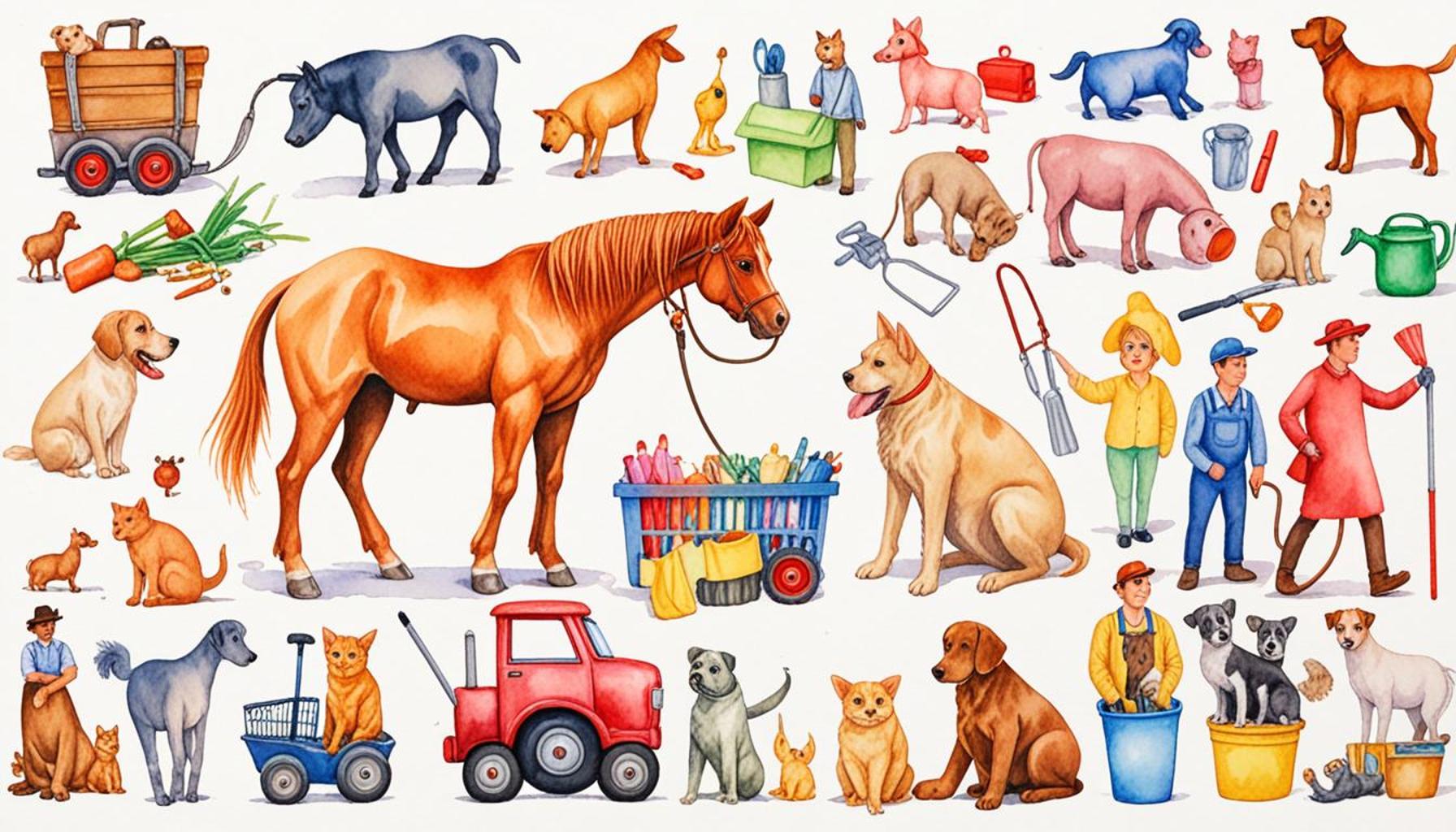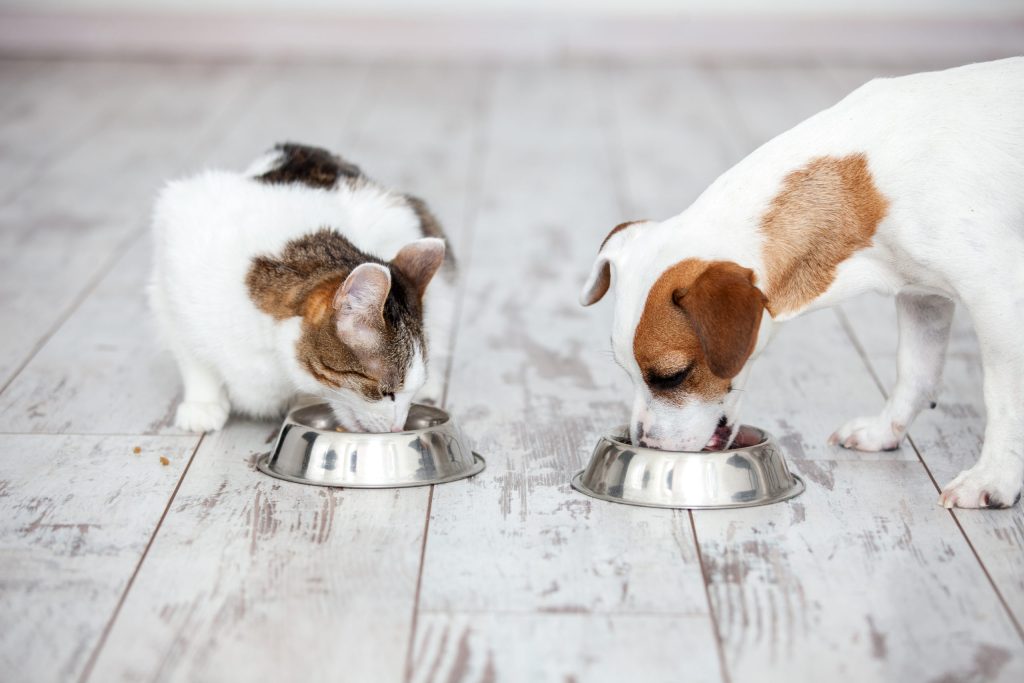Pet vs Working Animals Key Care Responsibility Differences

Understanding the Roles of Animals in Our Lives
Animals play a significant role in our lives, but the way we interact with them often varies greatly. Understanding the key care and responsibility differences between pets and working animals is essential for responsible ownership and effective care. This differentiation is not just about the types of animals but also encompasses the various obligations we take on as caretakers.
While pets are primarily companions, providing emotional support and joy, working animals serve crucial functions in various sectors, including agriculture, healthcare, and law enforcement. Here are some important distinctions:
- Pets – These are animals such as dogs, cats, and rabbits, which primarily serve the purpose of companionship and emotional bonding with humans.
- Working Animals – This category includes horses used in farming, service dogs trained to assist people with disabilities, and therapy animals that provide mental health support in hospitals or schools.
Each category requires different care and responsibilities. For example:
- Nutrition: Pets often have dietary needs centered around their specific health requirements and food preferences, necessitating a careful selection of pet food that caters to their age, breed, and activity level. For instance, senior dogs may require a different nutritional composition compared to their younger counterparts.
- Training: Working animals require specialized training tailored to their specific tasks. For example, search and rescue dogs undergo rigorous obedience and scent detection training to excel in their jobs, while therapy animals are trained to remain calm and gentle in often stressful environments.
- Social Interaction: Pets need daily attention and companionship to thrive emotionally, necessitating playtimes, walks, and engagement with their owners. In contrast, working animals may have schedules dictated by their job duties, which often require periods of intense focus followed by rest and recovery.
A key example of the difference in responsibilities is highlighted in the treatment of service dogs. These dogs are not only companions but also crucial aids for individuals with disabilities. They undergo extensive training to perform specific tasks, such as guiding the visually impaired or alerting those with hearing impairments to sounds in their environment. Their care must include regular exercise, proper nutrition, and ongoing training refreshers to ensure they remain effective in their roles.

As we delve into these differences, it becomes clear that one size does not fit all when it comes to animal care. The emotional bond with pets may differ substantially from the functional relationship with working animals. Recognizing and respecting these distinctions is vital for building a harmonious relationship with animals.
Join us as we explore the nuances of pet ownership versus the responsibilities of caring for working animals, shedding light on the enriching experiences and challenges each brings into our lives.
CHECK OUT: Click here to explore more
The Distinct Needs of Pets and Working Animals
As we navigate the responsibilities inherent in caring for animals, it’s crucial to recognize that pets and working animals require fundamentally different approaches to care. Understanding these differences not only ensures their well-being but also helps caretakers foster positive and productive interactions. Let’s take a deeper look at the specific care requirements for both categories.
Nutrition: A Cornerstone of Care
The nutritional needs of pets and working animals are tailored to their distinct roles in our lives. While pets, such as dogs and cats, often enjoy varied diets based on taste and health considerations, working animals typically require a diet that supports their physical exertion and job functions. For instance:
- Pets – Dogs might eat a balanced mix of premium kibble rich in proteins and fats, which supports a more sedentary lifestyle. Cats, being obligate carnivores, thrive on protein-dense diets tailored to their specific needs, taking into account their age and activity level.
- Working Animals – Horses engaged in farming or sport, for example, require high-energy feed that provides the stamina necessary for long hours of work. Similarly, service dogs must have diets that maintain their health and energy levels to effectively assist their owners.
This profound difference in nutritional requirements underscores the importance of selecting the appropriate vitals for each animal’s lifestyle. Proper nutrition is a critical part of animal welfare that directly influences their health, energy, and performance.
Training: Tailoring Skills to Roles
When it comes to training, the dichotomy between pets and working animals becomes even more pronounced. While both types require consistent training, the intensity and focus vary significantly.
- Pets – Basic obedience training is essential for pets, helping them understand commands and develop a strong bond with their owners. This includes sit, stay, and recall commands, which contribute to their safety and socialization.
- Working Animals – These animals undergo specialized training tailored to their specific jobs. For instance, police dogs are trained not only in obedience but also in scent detection, apprehension, and protection techniques. Likewise, therapy animals participate in training that enhances their ability to provide comfort and support in various environments, such as hospitals and nursing homes.
This specialized training not only highlights the responsibilities of the trainer but also emphasizes the commitment required to maintain the effectiveness of working animals in their roles. Regular training refreshers and socialization practices are integral to ensuring these animals successfully perform their vital functions.
Social Interaction: Different Dynamics
The social interaction needs of pets contrast sharply with those of working animals. Pets generally thrive on companionship and require regular interaction for their emotional health. Ensuring they receive adequate playtime and affection is crucial in cultivating their well-being. For example, a dog may need daily walks and engaged play sessions to remain happy and fulfill its social needs.
In contrast, working animals often have structured schedules determined by job demands. While they do require attention and care, their social interaction may be more task-focused. They may experience intense periods of working closely with humans, followed by periods of rest, emphasizing a different type of relationship.
As we delve deeper into these themes, it becomes increasingly clear that recognizing the unique needs of pets compared to working animals is essential for promoting their health and productivity in different roles. By understanding these differences, owners can better navigate the responsibilities linked to their roles as caretakers.
| Category | Key Features |
|---|---|
| Pet Animals | Companionship, emotional support, basic grooming |
| Benefits | Enhances mental well-being, low maintenance tasks |
| Working Animals | Task-oriented roles, extensive training required |
| Benefits | Critical for industries, requires dedicated care |
In analyzing the differences between pets and working animals, it becomes evident that each category fulfills unique roles that cater to different needs in society and individual households. Pet animals are primarily valued for their companionship, providing emotional support to their owners. The level of care for pets is typically less intense, focusing on standard grooming and basic health checks. This accessibility makes pet ownership appealing, as the benefits of having a furry friend often extend to improved mental health and reduced stress levels.On the other hand, working animals are trained extensively to perform specific tasks, making them indispensable in various sectors, from agriculture to assistance in law enforcement. Their roles demand a higher level of responsibility from owners, including continual training and tailored health care to ensure they are fit for duty. Understanding these responsibilities is crucial, as the commitment to a working animal often translates into significant contributions to community safety, agricultural productivity, and even personal assistance for people with disabilities. Each type of animal brings exceptional value to life, yet the duties involved in their care reflect a distinct landscape of responsibility and dedication.
CHECK OUT: Click here to explore more
Healthcare and Maintenance: The Diverging Responsibilities
When it comes to healthcare and maintenance, the responsibilities for pets and working animals are widely different. Understanding these distinctions can significantly impact the longevity and quality of life for both pets and working animals.
Routine Veterinary Care
Both pets and working animals require regular veterinary check-ups; however, the frequency and nature of these visits may differ based on their lifestyle and demands:
- Pets – Cats and dogs typically follow a standardized vaccination schedule ensuring they are protected against common diseases. Annual visits are often sufficient for pets, focusing on overall health assessments, vaccinations, and preventative measures such as flea and tick control.
- Working Animals – These animals often require more specialized and frequent veterinary care. For example, horses involved in competitive sports may need biannual check-ups to monitor fitness levels and address any musculoskeletal concerns. Similarly, working dogs in service roles may need regular evaluations, including orthopedic assessments, to ensure they can fulfill their demanding responsibilities without injury.
This distinction is critical, as working animals often endure stresses that can lead to injuries or health issues needing timely interventions. Thus, their healthcare plans must be diligently tailored to their rigorous physical demands.
Grooming: Tailored to Function
The grooming needs of pets and working animals also highlight the variability in care. While grooming may appear a secondary concern, it profoundly affects comfort, hygiene, and performance:
- Pets – Many pet owners engage in routine grooming practices such as brushing, bathing, and nail clipping to maintain their animals’ appearance and health. For instance, long-haired breeds require more frequent grooming to prevent matting and skin problems, while short-haired varieties may need less attention.
- Working Animals – Grooming extends beyond aesthetics and hygiene in working animals. For example, service dogs require regular coat maintenance to ensure their fur does not interfere with their harnesses or impede their performance. Similarly, horses must be groomed thoroughly to maintain their skin health and bond with their handlers, particularly before and after a hard day of work.
Additionally, grooming is often crucial in the assessment of potential health issues. Regular routines help spot skin irritations, parasites, and other conditions before they escalate.
Exercise Regimens: Balancing Energy and Task
The need for exercise varies significantly between pets and working animals. While both types require physical activity, the intensity and nature of that exercise reflect their roles:
- Pets – For dogs, daily walks and play sessions can facilitate both physical health and mental stimulation. Cats, too, benefit from interactive play that keeps them agile and entertained. Building a regular exercise routine contributes to a pet’s overall happiness and helps prevent behavioral issues that can arise from boredom.
- Working Animals – In contrast, working animals often engage in targeted exercises relevant to their jobs. For example, a herding dog might participate in agility and obedience training alongside regular work sessions to hone its skills. Horses, particularly those used for competition, follow structured training regimens to develop their strength and endurance, preparing them for demanding tasks.
With these differences in exercise, it becomes clear that while pets and working animals both benefit from physical activity, the focus and intensity of their routines differ considerably, shaped by their specific roles.
These key distinctions in healthcare, grooming, and exercise not only illustrate the varied responsibilities of caretakers but also point towards the nuances in ensuring both pets and working animals thrive in their respective roles. Understanding these differences can lead to more informed and responsible approaches to animal care.
CHECK OUT: Click here to explore more
Conclusion: Understanding the Variability in Animal Care
In examining the key care and responsibility differences between pets and working animals, it becomes evident that each type of animal demands a unique approach tailored to their specific needs. The distinctions in healthcare requirements, grooming practices, and exercise regimens highlight not only the varying levels of commitment from caregivers but also the complex relationships that develop between humans and animals in different contexts.
While the average pet owner may focus primarily on routine veterinary care and companionship, those responsible for working animals must consider specialized healthcare and rigorous training schedules to maintain peak performance. This understanding shapes how individuals approach their duties—whether it be through consistent monitoring of health and fitness for a service dog or the meticulous grooming and exercise routines necessary for horses in competitive environments.
Recognizing these differences is crucial for anyone involved in animal care, from pet enthusiasts to professionals in the agricultural and service sectors. By appreciating the varied responsibilities tied to each role, caregivers can enhance the welfare of their animals, fostering healthier, happier lives. Moreover, this nuanced understanding invites further exploration into the best practices and ongoing research in animal care, leading to more informed decisions and ultimately deepening the bond between humans and the animals they rely on.
As the lines between companionship and service blur in modern society, embracing these care distinctions will be vital for ensuring that both pets and working animals thrive harmoniously in our rapidly changing world. As we propel into the future, let us remain committed to learning more about the unique needs of these animal companions, ensuring that both pets and working animals receive the attention, care, and respect they rightfully deserve.



